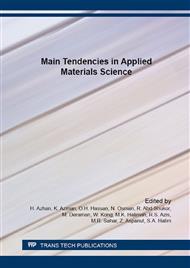[1]
Wong, W. (2008). Growing the Rose Myrtle for the Lunar New Year. Green Culture Singapore Feature Article for January, 1–6.
Google Scholar
[2]
Agro Forestry Tree Database. (1992). A tree species reference and selection guide: Rhodomyrtus tomentosa. Available from (http: /www. worldagroforestrycentre. org/sea/Products/AFDbases/afasp/SpeciesInfo. asp?SpID=18093) (Last accessedon 2. 9. 14).
Google Scholar
[3]
Do, T. L. (2011). SIM. In A. Ertr (Ed. ), Medicine plants and remedies of Vietnam (16th ed., p.434). Hanoi, Vietnam: Thoi Dai Publication House.
Google Scholar
[4]
Institute of Chinese Medicine (2010). Encyclopedia on contemporary medicinal plants: Rhodomyrtus tomentosa (Downy Rose Myrtle). Available from: (http: /www. hkjcicm. org/cm_database/plants/detail_e. aspx?herb_id=489> (Last accessed on 4. 9. 14).
Google Scholar
[5]
Pham, H. H. (2000). Rhodomyrtus tomentosa (Ait. ) Hassk. In An illustrated flora of Vietnam (Vol. 2, 2nd ed., p.43). Hanoi, Vietnam: Tre Publication House.
Google Scholar
[6]
M.K. Chong, K. Pita, S.T.H. Silalahi. (2009). Correlation between diffraction patterns and surface morphology to the model of oxygen diffusion into ITO films. Journal of Materials Chemistry and Physics 115 (154-157).
DOI: 10.1016/j.matchemphys.2008.11.039
Google Scholar
[7]
S. Hasiah, E. A . Ghapur, N. Amalina, A.N. Faizah, Y. Nusaibah, K. Ibrahim. (2010). Proceeding of 9th International annual Symposium on Sustainability Science and Management held on 8th -11th May 2010 at Kuala Terengganu, Terengganu (pp.841-848).
Google Scholar
[8]
Venkatasubramanian Sivakumar , J. Vijaeeswarri, and J. Lakshmi Anna. (2011). Effective natural dye extraction from different plant materials using ultrasound. Industrial Crops and Products 33 (2011) 116–122.
DOI: 10.1016/j.indcrop.2010.09.007
Google Scholar
[9]
N. A. Nik Aziz, M. I. N. Isa, and S. Hasiah. (2014). Electrical and Hall Effect Study of Hybrid Solar Cell. Journal of Clean Energy Technologies, Vol. 2, No. 4, October (2014).
DOI: 10.7763/jocet.2014.v2.148
Google Scholar
[10]
S. Hasiah, K. Ibrahim, H.B. Senin, and K.B.K. Halim. 2008. Electrical Conductivity of Chlorophyll with Polythiophene Thin Film on Indium Tin Oxide as P-N Heterojunction Solar Cell. Journal of Physical Science 19(2): 77–92.
DOI: 10.1063/1.3160184
Google Scholar
[11]
Unknown author. 7600 series Hall system hardware references manual.
Google Scholar
[12]
H. Salleh. (2012). UMT Hall effect measurement software with corporation of Dr Salleh, LEIOS-Software and Nanorian technology, unpublished.
Google Scholar
[13]
Kewei Sun, Wancheng Zhou, Xiufeng Tang, Zhibin Huang, Fa Lou, Dongmei Zhu. (2011). Effect of the heat treatment on the infrared emissivity of indium tin oxide (ITO) Films. Applied Surface Science 257 (2011) 9639–9642.
DOI: 10.1016/j.apsusc.2011.06.089
Google Scholar
[14]
I. Baía, B. Fernandes, P. Nunes, M. Quintela, and R. Martins. (2001). Influence of the process parameters on structural and electrical properties of r. f. magnetron sputtering ITO films. Thin Solid Films 383(1-2): 244-247.
DOI: 10.1016/s0040-6090(00)01589-3
Google Scholar
[15]
K.B. Sundaram and J. Blanchard, J. (1997). Deposition and annealing studies of indium tin oxide films. Proceedings IEEE Southeastcon 97. `Engineering the New Century, held on 12 th – 14th April 1997 at Blacksburg, USA (p.230 – 232).
DOI: 10.1109/secon.1997.598677
Google Scholar
[16]
X.W. Sun, D.H. Kim, and H.S. Kwok. (1997). Ultra thin ITO films deposited on various substrates by pulsed laser deposition. MRS Proceeding in Boston, MA, USA, Dec 2-5, p.485: 267-72.
DOI: 10.1557/proc-485-267
Google Scholar
[17]
Shinji Takayama, Toshifumi Sugawara, Akira Tanaka, and Tokuji Himuro. (2003). Indium tin oxide films with low resistivity and low internal stress. Journal of Vacuum Science Technology A 21(4): 1351-1354.
DOI: 10.1116/1.1563623
Google Scholar
[18]
S.A. Bashar. (1997). Study of Indium Tin Oxide (ITO) for Novel Optoelectronic Devices. Doctor of Philosophy thesis. http: /www. betelco. com/sb/phd/acknowle. html. Accessed on 7th July (2014).
Google Scholar
[19]
Hsin Her Yu, Shug-June Hwang, Ming-Chun Tseng, and Chien-Chang Tseng. (2006). The effect of ITO films thickness on the properties of flexible organic light emitting diode. Optics Communications 259(1): 187-193.
DOI: 10.1016/j.optcom.2005.08.053
Google Scholar
[20]
Lei Hao, Xungang Diao, Huaizhe Xu, Baoxia Gu, Tianmin Wang. (2008). Thickness dependence of structural, electrical and optical properties of indium tin oxide (ITO) films deposited on PET substrates. Applied Surface Science 254: 3504–3508.
DOI: 10.1016/j.apsusc.2007.11.063
Google Scholar
[21]
Hu. (2014). accessed on January 2014. http: /www. eecs. berkeley. edu/~hu/Chenming-Hu_ch1. pdf.
Google Scholar
[22]
C. Hilsum and A.C. Rose Innes. (1961). Semi conducting III-V compound. Pergamon, Oxford p.120.
Google Scholar


